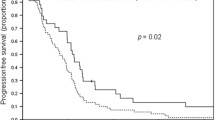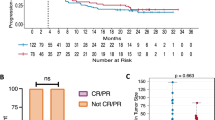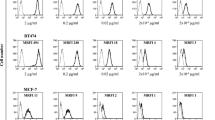Abstract
Immunotherapy with the EGFR-specific mAb cetuximab is clinically effective in 10–20% of patients with squamous cell carcinoma of the head and neck (SCCHN). Little information is available about the mechanism(s) underlying patients’ differential clinical response to cetuximab-based immunotherapy, although this information may contribute to optimizing the design of cetuximab-based immunotherapy. Our understanding of these mechanisms would benefit from the characterization of the variables which influence the extent of cell dependent-lysis of SCCHN cells incubated with cetuximab in vitro. Therefore, in this study we have investigated the role of FcγR IIIa-158 genotype expressed by effector NK cells, cetuximab concentration, and EGFR expression level by SCCHN cells in the extent of their in vitro lysis and in the degree of NK cell activation. PBMC or purified CD56+ NK cells genotyped at IIIa codon 158 and SCCHN cell lines expressing different levels of EGFR have been used as effectors and targets, respectively, in antibody dependent cellular cytotoxicity (ADCC) assays. Furthermore, supernatants from ADCC assays were analyzed for cytokine and chemokine levels using multiplexed ELISA. We found that the extent of lysis of SCCHN cells was influenced by the EGFR expression level, cetuximab concentration, and FcγR polymorphism. Effector cells expressing the FcγR IIIa-158 VV allele were significantly (P < 0.0001) more effective than those expressing FcγR IIIa VF and VV alleles in mediating lysis of SCCHN cells expressed higher levels of the activation markers CD69 and CD107a, and secreted significantly (P < 0.05) larger amounts of inflammatory cytokines and chemokines. IL-2 or IL-15 treatment increased cetuximab-mediated ADCC by poor binding FcγR IIIa 158 FF expressing NK cells. The importance of the FcγR IIIa-158 polymorphism in cytotoxicity of SCCHN cells by NK cells supports a potential role for immune activation and may explain patient variability of cetuximab mediated clinical responses. Cellular and secreted immune profiles and FcγR genotypes from patients’ lymphocytes may provide clinically useful biomarkers of immune activation in cetuximab treated patients.





Similar content being viewed by others
References
Ang KK, Berkey BA, Tu X et al (2002) Impact of epidermal growth factor receptor expression on survival and pattern of relapse in patients with advanced head and neck carcinoma. Cancer Res 62(24):7350–7356
Grandis JR, Tweardy DJ (1993) Elevated levels of transforming growth factor alpha and epidermal growth factor receptor messenger RNA are early markers of carcinogenesis in head and neck cancer. Cancer Res 53(15):3579–3584
Bonner JA, Harari PM, Giralt J et al (2006) Radiotherapy plus cetuximab for squamous-cell carcinoma of the head and neck. N Engl J Med 354(6):567–578
Vermorken JB, Mesia R, Vega-Villegas ME et al (eds) (2006) Cetuximab in combination with cisplatin or carboplatin and 5-fluorouracil (5-FU) in the first-line treatment of patients with recurrent and/or metastatic squamous cell carcinoma of the head and neck (R&M SCCHN) (EXTREME). In: ASCO annual meeting proceedings, part I, vol 24
Taylor C, Hershman D, Shah N et al (2007) Augmented HER-2 specific immunity during treatment with trastuzumab and chemotherapy. Clin Cancer Res 13(17):5133–5143
Varchetta S, Gibelli N, Oliviero B et al (2007) Elements related to heterogeneity of antibody-dependent cell cytotoxicity in patients under trastuzumab therapy for primary operable breast cancer overexpressing Her2. Cancer Res 67(24):11991–11999
Zhang W, Gordon M, Schultheis AM et al (2007) FCGR2A and FCGR3A polymorphisms associated with clinical outcome of epidermal growth factor receptor expressing metastatic colorectal cancer patients treated with single-agent cetuximab. J Clin Oncol 25(24):3712–3718
Lin CJ, Grandis JR, Carey TE et al (2007) Head and neck squamous cell carcinoma cell lines: established models and rationale for selection. Head Neck 29(2):163–188
Thomas SM, Zeng Q, Epperly MW et al (2004) Abrogation of head and neck squamous cell carcinoma growth by epidermal growth factor receptor ligand fused to pseudomonas exotoxin transforming growth factor alpha-PE38. Clin Cancer Res 10(20):7079–7087
Hathaway B, Landsittel DP, Gooding W et al (2005) Multiplexed analysis of serum cytokines as biomarkers in squamous cell carcinoma of the head and neck patients. Laryngoscope 115(3):522–527
Lopez-Albaitero A, Ferris RL (2007) Immune activation by epidermal growth factor receptor specific monoclonal antibody therapy for head and neck cancer. Arch Otolaryngol Head Neck Surg 133(12):1277–1281
Robert F, Ezekiel MP, Spencer SA et al (2001) Phase I study of anti-epidermal growth factor receptor antibody cetuximab in combination with radiation therapy in patients with advanced head and neck cancer. J Clin Oncol 19(13):3234–3243
Sok JC, Coppelli FM, Thomas SM et al (2006) Mutant epidermal growth factor receptor (EGFRvIII) contributes to head and neck cancer growth and resistance to EGFR targeting. Clin Cancer Res 12(17):5064–5073
Kalyankrishna S, Grandis JR (2006) Epidermal growth factor receptor biology in head and neck cancer. J Clin Oncol 24(17):2666–2672
Musolino A, Naldi N, Bortesi B et al (2008) Immunoglobulin G fragment C receptor polymorphisms and clinical efficacy of trastuzumab-based therapy in patients with HER-2/neu-positive metastatic breast cancer. J Clin Oncol 26(11):1789–1796
Weng WK, Levy R (2003) Two immunoglobulin G fragment C receptor polymorphisms independently predict response to rituximab in patients with follicular lymphoma. J Clin Oncol 21(21):3940–3947
Roda JM, Joshi T, Butchar JP et al (2007) The activation of natural killer cell effector functions by cetuximab-coated, epidermal growth factor receptor positive tumor cells is enhanced by cytokines. Clin Cancer Res 13(21):6419–6428
Dall’Ozzo S, Tartas S, Paintaud G et al (2004) Rituximab-dependent cytotoxicity by natural killer cells: influence of FCGR3A polymorphism on the concentration–effect relationship. Cancer Res 64(13):4664–4669
Cartron G, Dacheux L, Salles G et al (2002) Therapeutic activity of humanized anti-CD20 monoclonal antibody and polymorphism in IgG Fc receptor FcgammaRIIIa gene. Blood 99(3):754–758
Mitrovic Z, Aurer I, Radman I, Ajdukovic R, Sertic J, Labar B (2007) FCgammaRIIIA and FCgammaRIIA polymorphisms are not associated with response to rituximab and CHOP in patients with diffuse large B cell lymphoma. Haematologica 92(7):998–999
Lu Y, Li X, Liang K et al (2007) Epidermal growth factor receptor (EGFR) ubiquitination as a mechanism of acquired resistance escaping treatment by the anti-EGFR monoclonal antibody cetuximab. Cancer Res 67(17):8240–8247
Wild R, Fager K, Flefleh C et al (2006) Cetuximab preclinical antitumor activity (monotherapy and combination based) is not predicted by relative total or activated epidermal growth factor receptor tumor expression levels. Mol Cancer Ther 5(1):104–113
Psyrri A, Egleston B, Weinberger P et al (2008) Correlates and determinants of nuclear epidermal growth factor receptor content in an oropharyngeal cancer tissue microarray. Cancer Epidemiol Biomarkers Prev 17(6):1486–1492
Kawaguchi Y, Kono K, Mimura K, Sugai H, Akaike H, Fujii H (2007) Cetuximab induce antibody-dependent cellular cytotoxicity against EGFR-expressing esophageal squamous cell carcinoma. Int J Cancer 120(4):781–787
Kurai J, Chikumi H, Hashimoto K et al (2007) Antibody-dependent cellular cytotoxicity mediated by cetuximab against lung cancer cell lines. Clin Cancer Res 13(5):1552–1561
Aerts HJ, Dubois L, Hackeng TM et al (2007) Development and evaluation of a cetuximab-based imaging probe to target EGFR and EGFRvIII. Radiother Oncol 83(3):326–332
Yang W, Wu G, Barth RF et al (2008) Molecular targeting and treatment of composite EGFR and EGFRvIII-positive gliomas using boronated monoclonal antibodies. Clin Cancer Res 14(3):883–891
Patel D, Lahiji A, Patel S et al (2007) Monoclonal antibody cetuximab binds to and down-regulates constitutively activated epidermal growth factor receptor vIII on the cell surface. Anticancer Res 27(5A):3355–3366
Linkov F, Lisovich A, Yurkovetsky Z et al (2007) Early detection of head and neck cancer: development of a novel screening tool using multiplexed immunobead-based biomarker profiling. Cancer Epidemiol Biomarkers Prev 16(1):102–107
Kuss I, Hathaway B, Ferris RL, Gooding W, Whiteside TL (2004) Decreased absolute counts of T lymphocyte subsets and their relation to disease in squamous cell carcinoma of the head and neck. Clin Cancer Res 10(11):3755–3762
Acknowledgments
This work has been funded by a pilot grant from the American Head and Neck Society (ALA and RLF) and R01 DE19727 (RLF).
Author information
Authors and Affiliations
Corresponding author
Additional information
An erratum to this article can be found at http://dx.doi.org/10.1007/s00262-009-0726-3
Rights and permissions
About this article
Cite this article
López-Albaitero, A., Lee, S.C., Morgan, S. et al. Role of polymorphic Fc gamma receptor IIIa and EGFR expression level in cetuximab mediated, NK cell dependent in vitro cytotoxicity of head and neck squamous cell carcinoma cells. Cancer Immunol Immunother 58, 1853–1862 (2009). https://doi.org/10.1007/s00262-009-0697-4
Received:
Accepted:
Published:
Issue Date:
DOI: https://doi.org/10.1007/s00262-009-0697-4




